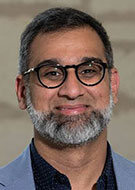Knowing When to Respond to Incidental Findings
Aggressive management of incidentalomas can lead to poor patient outcomes and other negative consequences




This is the third in a series of articles about radiologists’ role in the identification and communication of incidental findings. Read the first and second articles in the series.
Incidentalomas—unexpected, abnormal findings—occur in 20% to 40% of all advanced imaging studies, according to Matthew Davenport, MD, MBA, the William Martel Professor of Radiology and professor of urology at Michigan Medicine in Ann Arbor. In an American Journal of Roentgenology article, Dr. Davenport noted that incidental findings often lead to low-value care.
“Some cancers are indolent and may never hurt a patient if they had never been detected,” Dr. Davenport said.
Identifying such indolent cancers and treating them early often contributes to patient harms without improving patient care, he noted.
“Highly-aggressive, lethal cancers usually warrant treatment when found—but it’s rare for them to be discovered incidentally in patients who don’t already show symptoms,” Dr. Davenport said.
Finally, some cancers fall in the middle: they have the potential to harm, but they are not as fast growing as highly aggressive types. Dr. Davenport asserted that these cancers are most suited to early detection and treatment using typical imaging methods.
When Context Shapes Importance
Many patients and providers have different feelings about the potential benefits of addressing incidentilomas compared to the potential harms of test anxiety, unnecessary costs and complications from unnecessary complications. Grappling with these complexities is challenging.
According to Dr. Davenport, the importance of an incidental finding depends a lot on the patient’s other health risks. “For example, if a scan picks up a small pulmonary nodule, it is often benign,” he said. “However, if the patient is a smoker, which is a major risk factor for lung cancer, the risk of the finding goes up, and our approach to it changes. Risk factors have a large role in determining the importance of an incidental finding.”
Many guidelines describing the management of incidental findings are overly weighted toward missing a potential cancer, with less regard given to whether identification improves health, Dr. Davenport noted. “This focus on sensitivity rather than the complications of overdiagnosis and overtreatment fuels the population-level harm and economic loss resulting from over-pursuit of incidental findings that have repeatedly been shown in large studies of incidental findings management,” he said.
Many abdominal incidentalomas will only harm the patient if the radiologist’s response leads to an unnecessary series of workups, according to Perry J. Pickhardt, MD, John R. Cameron Professor of Radiology and Medical Physics and chief of gastrointestinal imaging at the University of Wisconsin, Madison.
In a British Journal of Radiology commentary, Dr. Pickhardt emphasized that these workups can cause patient anxiety as well as unnecessary costs and complications. He also noted that it’s important not to confuse imaging-based incidentalomas with the practice of opportunistic screening.
“They are quite different,” Dr. Pickhardt said. “Incidental findings often carry a more negative connotation and require radiologists to responsibly handle unsuspected imaging findings while being careful not to trigger unnecessary additional workups.”
“On the other hand, opportunistic screening implies leveraging useful imaging data, such as tissue and organ measures present in all patients,” he continued. “For example, routine body CT is an ideal high-volume modality for quantitative assessment of tissue composition that can assist with cardiometabolic risk stratification and identification of presymptomatic conditions like osteoporosis or heart disease.”

Communicating Nonemergent Findings
According to Fides R. Schwartz, MD, it’s beneficial to have a closed-loop system in place for communicating with patients and providers about important nonemergent findings. In such a system, the sender transmits information, the recipient acknowledges it, and the patient receives appropriate follow-up care.
Dr. Schwartz is lead investigator at the Center for Advanced CT Translation and Innovation at Brigham and Women’s Hospital and assistant professor at Harvard Medical School in Boston. She recently published a Radiology study about a navigator integrated into the electronic health record system to handle unexpected findings at her former institution, Duke University in Durham, NC.
In the study, three navigators who had been trained as radiologic technologists and sonographers facilitated communication and documentation of nonemergent findings to patients as well as providers. The study focused on 3,542 examinations reported within a 12-month period.
In total, 11% of unexpected findings identified on imaging studies led to the diagnosis of malignant neoplasms, while 5% led to finding treatable vascular abnormalities as well as other clinically relevant entities.
“Having such a program is helpful for patients in the mid- to long-term, as their follow-up imaging or other care can be better tailored to their individual needs, be more closely monitored and findings are less likely to ‘fall through the cracks’ of multiple health care professionals communicating with each other,” Dr. Schwartz said.
In a related editorial on the study, Nabile M. Safdar, MD, MPH, noted that the examinations reported through the program resulted in more than 100 referrals for consultations, over 100 non-radiology procedures and over 2,000 follow-up imaging examinations.
Dr. Safdar is interim chief artificial intelligence officer at Emory Healthcare and endowed professor and vice chair of informatics in the Department of Radiology and Imaging Sciences at Emory University in Atlanta.
“Successfully managing incidental findings requires a systematic approach that integrates people, processes and technology,” he said. “Achieving sustainable success demands early and deliberate collaboration with hospital leadership, referring specialties and other key stakeholders.”
Even when an incidental finding may not need treatment, discussing it with a patient is often important, Dr. Davenport said. Some patients may want additional tests or biopsy to be certain, while others prefer reassurance and no action. Deciding unilaterally not to inform patients removes their rights to autonomy and self-determination.“Like a Greek tragedy, we keep making the same mistakes in aggressively managing them. Trials are urgently needed in which we test the best way to approach incidental findings, with ‘ignore’ being a reasonable option with strong equipoise in many populations.”
— MATTHEW DAVENPORT, MD, MBA
The Need for More Research
Incidental findings are insidious because they may create the illusion of benefit while causing harm, and they can do so on a tremendous scale, Dr. Davenport said.
“Like a Greek tragedy, we keep making the same mistakes in aggressively managing them,” he added. “Trials are urgently needed in which we test the best way to approach incidental findings, with ‘ignore’ being a reasonable option with strong equipoise in many populations.”
Dr. Safdar agreed that radiologists must take great care in determining which incidental findings require follow-up.
“Applying evidence-driven recommendations helps avoid unnecessary testing, reduces patient anxiety and promotes high-value care,” Dr. Safdar said. “At the same time, failing to identify and communicate an incidental finding that requires follow-up—especially when it leads to a poor patient outcome—represents one of the most serious failures of our system and undermines the trust patients place in us.”
For More Information
Access the Radiology article, “Opportunistic Screening: Radiology Scientific Expert Panel.”
Access the Radiology article, “Electronic Health Record Closed-Loop Communication Program for Unexpected Nonemergent Findings,” and the related editorial, “How to Center Patients by Managing Unexpected Findings.”
Access the American Journal of Roentgenology article, “Incidental Findings and Low-Value Care.”
Access the British Journal of Radiology article, “Incidentalomas at abdominal imaging.”
Read previous RSNA News articles on incidental findings:
- The Challenges of Communicating Incidental Findings
- Direct-to-Consumer Imaging Centers Offer Whole Body Imaging with Little Context